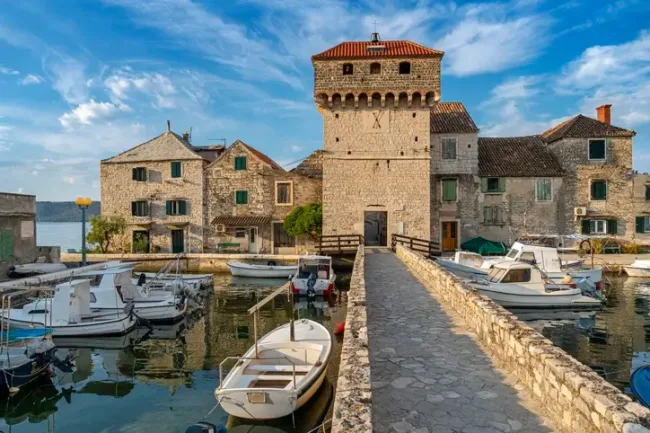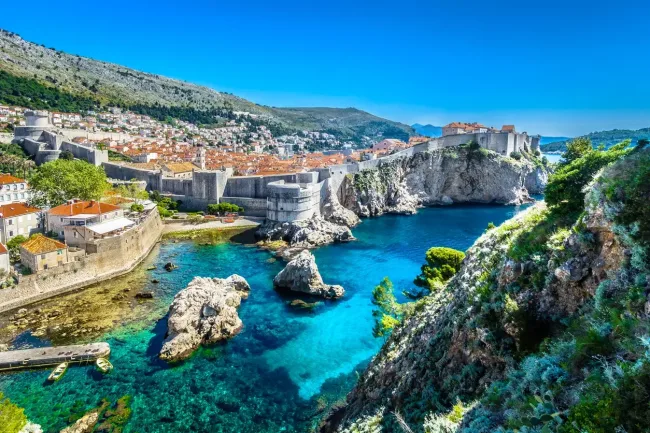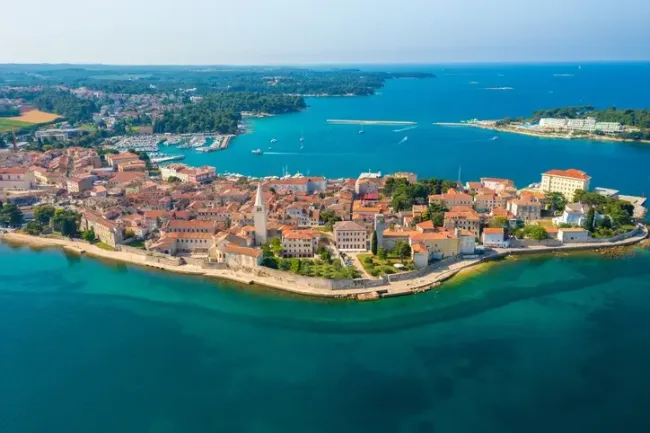
Welcome to Croatia

Croatia is a country that offers a perfect blend of stunning landscapes, rich history, and vibrant culture. With its breathtaking coastlines, picturesque medieval cities, and world-famous national parks, it is a must-visit destination for any travel enthusiast.
We're here to provide you with the ultimate Croatia travel guide, packed with insider tips and tricks to help you plan an unforgettable trip. From Krka National Park's serene beauty to Zagreb's bustling nightlife, there's something for everyone in this enchanting country.
So whether you're planning a romantic getaway or a family adventure, let us be your go-to resource for Croatia travel tips. Start packing your bags and get ready to explore the wonders of this fantastic country.
Document checklist for Croatia
If you're planning a trip to Croatia, it's important to ensure that you have all the necessary documents before you arrive. Here's a checklist of what you'll need to enter the country:
-
A valid passport, with at least three months of validity beyond the length of your stay
-
A Schengen visa (if required) or ETIAS, depending on your country of origin.
-
Proof of sufficient funds to cover your stay in Croatia
-
A return airline ticket or evidence of onward travel
Essential Croatia travel information
Croatia is a beautiful destination for travelers seeking history, culture, and natural beauty. Here's some essential travel information to help you plan your trip:
-
Croatian Currency - Croatian Kuna (HRK). $1 is equivalent to approx. HRK 6.5.
-
Daily budget for one person - A budget of HRK 500-700 (approx. $80-110 USD) per day should cover accommodation, food, and transportation costs for budget-conscious travelers.
-
Languages - As the official language, most people speak Croatian, but many locals also speak English and other European languages.
-
Number of travelers per year - Croatia attracts over 19 million visitors, with the majority coming from European countries such as Germany, the UK, and Italy.
-
Socket type - The standard voltage is 230V and the frequency is 50Hz. The sockets are type C and F.
-
Time zone - Croatia is in the Central European Time Zone, GMT+1. During daylight saving time, the country is GMT+2.
-
Top 3 cities to visit - Dubrovnik, Split, and Zagreb are all must-visit cities for their historical landmarks, vibrant culture, and breathtaking scenery.
-
Top 3 landmarks/monuments - The ancient city walls of Dubrovnik, the Diocletian's Palace in Split, and the Plitvice Lakes National Park are some of the top landmarks and monuments that visitors to Croatia should not miss.
Visa information for Croatia
US citizens can enjoy up to 90 days in Croatia without a visa, while EU citizens can stay unlimitedly.
As of 2023, the introduction of the ETIAS (European Travel Information and Authorization System) will apply to US citizens traveling to the Schengen Area, which includes Croatia. Travelers from countries requiring a visa must apply for a Schengen visa before their trip, as Croatia officially became part of the Schengen zone in 2023.
Croatia ETIAS
The Croatia ETIAS (European Travel Information and Authorization System) is a travel authorization required for US citizens and other visa-exempt travelers entering the Schengen Area, including Croatia, starting in 2023.
The ETIAS allows for stays of up to 90 days within 180 days. You can apply for the Croatia ETIAS online through our user-friendly platform, and processing times are typically within minutes to a few hours. All you need is a valid passport and essential details to apply today.
Croatia Schengen Visa
The Croatia Schengen Visa is required for travelers from countries that are not visa-exempt to enter the Schengen Area, which includes Croatia. The visa allows for stays of up to 90 days within 180 days and can be valid for single or multiple entries.
The application process can be lengthy and requires several documents, including a passport, travel itinerary, and proof of accommodation. Our team of experts is here to guide you through the process and make it as smooth as possible. So apply now!
Visa difficulty index for Croatia
Accessibility: 3/5
Getting a visa for Croatia is generally accessible for most travelers, especially for those who are citizens of countries within the European Union. Citizens of certain other countries, such as the USA, Canada, and Australia, can enter Croatia for up to 90 days without a visa. However, citizens of other countries may need to apply for a visa in advance, which can require additional documentation and an in-person interview at the embassy or consulate.
Time to get your visa: 4/5
The processing time for a visa to Croatia can vary depending on the applicant's nationality, and the type of visa applied. It can be lengthy; however, with iVisa, the process is much faster and more efficient.
Costs: 3/5
The cost of getting a visa for Croatia can vary depending on the applicant's nationality and the type of visa applied. The visa fees the Croatian government charges are generally reasonable but can still be expensive for some travelers. Remember that an additional processing fee is charged when you use iVisa’s services.
Typical costs and budget for Croatia
The cost of traveling in Croatia can vary depending on your travel style and the cities you visit. However, on average, you can spend around 600-800 HRK per day per person (around $90- $120) on a moderate budget, which should cover meals, transportation, and basic accommodations.
Daily spending per person - $90-$120 per day
-
Meals - $20 - $60 per day
-
Transport - $8-$15 for a journey between major cities
-
Hotel - Budget hotel or hostel: $45-$75 per night or luxury hotel: $150+ per night
Moderate budget: $1,200-$1,800 for one-week for two people, including transportation, accommodations, and meals.
Transport and ways to travel around Croatia
Croatia has various transportation options for traveling within the country, including buses, trains, ferries, and car rentals.
Flying to Croatia
Croatia has several airports, but the main international airport is Franjo Tuđman Airport in the capital city of Zagreb. Here are some airlines that offer direct flights to Croatia from major destinations:
-
Croatia Airlines: offers direct flights from several European cities, including Amsterdam, Frankfurt, London, Paris, and Rome.
-
Lufthansa: offers direct flights from Frankfurt to Zagreb.
-
British Airways: offers direct flights from London to Zagreb.
-
Ryanair: offers direct flights from several European cities, including Dublin, Berlin, and Rome, to Zadar and Pula.
-
EasyJet: offers direct flights from London, Berlin, and Paris to Split and Dubrovnik.
-
Norwegian Air: offers direct flights from Stockholm to Split. Other airports in Croatia that are served by international flights include Split Airport, Dubrovnik Airport, Pula Airport, and Zadar Airport.
Arrival and immigration tips for Croatia
-
If you need a visa to enter Croatia, apply for one in advance. Make sure to have all necessary travel documents, including a valid passport, return ticket, and any visas or permits required for your nationality and purpose of travel. You can upload these to the iVisa App to have everything in one convenient place.
-
If you're arriving at a major airport, such as Franjo Tuđman Airport in Zagreb or Split Airport, there are often long queues at immigration during peak travel season, so be prepared to wait. Having some local currency on hand is also good if you need to pay any fees or taxes upon arrival.
-
If you're traveling to Croatia by car or bus, you may need to go through a border crossing, where there may be *long queues and strict border controls. Ensure you have all necessary documents for your vehicle and passengers, including insurance and registration papers.
-
For those flying into a smaller airport, such as Zadar or Pula, there may be fewer immigration officers on duty, so be prepared for potentially long waits. However, these airports are generally less crowded and easier to navigate than larger airports.
-
When taking a taxi or private transfer to your accommodation, agree on a price beforehand to avoid being overcharged. Alternatively, you can use public transportation, such as buses or trains, which are often cheaper and more convenient. Many airports have regular bus services to major cities and tourist destinations in Croatia.
-
If you're renting a car at the airport, familiarize yourself with the local traffic laws and regulations and the rental company's policies and insurance coverage. Croatians drive on the right side of the road and use the metric system for distance and speed.
Best ways to travel around Croatia
Explore Croatia by bus
The most common form of transport in Croatia is by bus. Numerous bus companies operate routes throughout the country, and it's generally a cost-effective and efficient way to travel. Most bus stations offer the option to buy tickets in advance or on the day of travel. It's recommended to book in advance for popular routes, particularly during peak tourist season.
Taking a ferry or catamaran
This is a popular option for those looking to explore the coastal regions. There are regular ferry services connecting the mainland with many of Croatia's islands and ferries that travel between major coastal cities. It's advisable to book in advance for peak season and popular routes.
Explore Croatia by sailing.
This is perfect for those who want to enjoy day trips through the crystal-clear waters of the Adriatic Sea to discover hidden coves and secluded beaches of more than 1,000 islands in Croatia. There are four designated sailing routes along the Adriatic coast you can explore.
Train or car rental
For those sticking to land, there are options to travel by train or car rental f if you are looking for more flexibility and independence. When using public transport, it's important to note that some cities require a travel card to be purchased in advance, while others allow cash payment on board. It's always a good idea to research each location's specific transport options and requirements before traveling.
Safety in Croatia
Croatia is generally a very safe country for travelers. The crime rate is low, and violent crime is rare. However, as with any destination, you must be aware of your surroundings and take some precautions to stay safe. Here are a few tips to help you stay safe during your visit to Croatia:
-
Be vigilant in crowded areas. Pickpocketing and theft are more common in tourist areas and on public transportation. Keep your belongings close to you and be aware of your surroundings.
-
Use common sense when drinking alcohol. Alcohol is widely consumed in Croatia, and excessive drinking can lead to risky behavior. Always watch your drink, and never accept drinks from strangers.
-
Stay in well-lit areas at night. Like many other cities, some parts of Croatian cities can be dangerous at night, especially if poorly lit or isolated. Stick to well-traveled streets and avoid walking alone at night if possible.
-
Be cautious when driving. Croatia has many winding and narrow roads, and some drivers can be aggressive. Always wear a seatbelt, obey traffic laws, and be aware of other drivers.
Weather in Croatia
Croatia has a Mediterranean climate with hot, dry summers and mild, rainy winters. The best time to visit Croatia is during the summer, from June to September, when the weather is warm and sunny.
Temperatures during this season average around 28-30°C (82-86°F) along the coast and 22-26°C (72-79°F) inland, making it perfect for enjoying the beaches and outdoor activities. Lightweight clothing, sunscreen, and a hat are essential, while a light jacket or sweater may be needed for cooler evenings.
Spring and fall are shoulder seasons in Croatia, with cooler temperatures and fewer crowds. Temperatures during these seasons average around 15-20°C (59-68°F) along the coast and 10-15°C (50-59°F) inland. Packing layers, including a jacket or sweater, and waterproof shoes or boots in case of rain is a good idea.
Winter in Croatia is generally mildbut can be cold and snowy in the interior regions. Coastal areas are milder, with temperatures averaging around 10°C (50°F). If you're visiting Croatia in the winter, pack warm clothing, including a coat, hat, gloves, and waterproof boots. With the mild and enjoyable weather throughout most of the year, Croatia is a beautiful country to visit anytime, as long as you pack appropriately for the season.
Must do and see in Croatia
-
Dubrovnik: Known as the "Pearl of the Adriatic," Dubrovnik is a beautiful medieval walled city on Croatia's southern coast. The best time to visit is during the summer when you can stroll along the city's ancient walls, visit the Franciscan Monastery, and explore the Old Town. Be sure to try local seafood dishes like octopus salad or black risotto.
-
Plitvice Lakes National Park: Located in central Croatia, Plitvice Lakes National Park is a UNESCO World Heritage Site and one of the most beautiful natural attractions in the country. It's best to visit in the spring or fall when the crowds are smaller, and the waterfalls and lakes are most attractive. Take the chance to take a boat ride on the lake and try some of the local cheeses and wines.
-
Diocletian's Palace: Located in the coastal city of Split, Diocletian's Palace is an impressive Roman monument dating back to the 4th century. You can wander through the palace's ancient streets, explore the cellars, and climb to the top of the Bell Tower for panoramic city views. Be sure to try some local lamb dishes and the famous Dalmatian wines.
-
Hvar Island: Located off the coast of Split, Hvar Island is a beautiful and popular destination for sun, sea, and nightlife. The island is home to beautiful beaches, clear waters, and picturesque towns. The best time to visit is during the summer when the island is alive with music festivals and beach parties. Be sure to try some of the local olive oil and lavender products.
-
Rovinj: Located on the Istrian Peninsula in northern Croatia, Rovinj is a beautiful and colorful coastal town. Its narrow streets are lined with colorful houses and shops, and its harbor is filled with fishing boats and yachts. Be sure to visit the Church of St. Euphemia, climb to the top of the Bell Tower for panoramic views, and try some of the local truffles and Istrian wines. The best time to visit is during the summer when the town is alive with music festivals and outdoor markets.
Typical Croatian foods to try
-
Peka: a traditional Croatian dish made by roasting meat and vegetables under a metal lid called a peka. The dish is slow-cooked over an open fire or in an oven, resulting in a delicious, tender, and aromatic meal. It's typically made with lamb, veal, or octopus and is often served with potatoes, carrots, and onions.
-
Ćevapi: grilled, skinless sausages made from a blend of beef and lamb or pork, often served in pita bread with onions and a sour cream-based sauce called ajvar. They are popular street food in Croatia and throughout the Balkans and can be found at most local markets and food stands.
-
Pašticada: a slow-cooked beef stew often considered one of Croatia's most iconic dishes. The beef is marinated in red wine and spices overnight, then slow-cooked with prunes, bacon, and vegetables. The stew is traditionally served with gnocchi or homemade pasta and topped with a sauce made from the meat's marinade.
-
Burek: a savory pastry with layers of flaky phyllo dough filled with meat, cheese, or vegetables. It's a popular snack food in Croatia and can be found at most bakeries and street vendors. It's often served with yogurt or sour cream on the side.
-
Strukli: a traditional Croatian cheese pastry made with layers of dough filled with fresh cheese, sour cream, eggs, and butter. It's typically served as a side dish or appetizer and can be found in most traditional restaurants throughout Croatia. It's often topped with butter and breadcrumbs and baked until golden and bubbly.
Vaccine information for Croatia
Croatia does not require travelers to show proof of full Covid-19 vaccination, a negative PCR test taken within 72 hours of arrival, or evidence of recovery from Covid-19 within the last 90 days. However, it is recommended that all travelers be fully vaccinated.
The CDC also recommends that all travelers to Croatia be up-to-date on routine vaccinations, such as measles-mumps-rubella (MMR), diphtheria-tetanus-pertussis, varicella (chickenpox), polio, and the yearly flu shot. Travelers to Croatia should also consider vaccinating against hepatitis A and B and rabies if they plan to participate in outdoor activities or have close contact with animals.
Moreover, some travelers may be required to show proof of Yellow Fever vaccination if they are coming from or have recently visited a Yellow Fever endemic country.
Home to the world’s smallest town
Croatia is home to the world's smallest town, called Hum, located in the country's Istria region. Hum has a population of only about 20 people and covers an area of just 100 meters.
Despite its small size, Hum has a rich history and is known for its well-preserved medieval architecture, including a town wall and a 12th-century church. It is also famous for producing biska, a traditional Istrian brandy made with mistletoe.
If you are up for it, you can enter the city through the 3 km long Glagolitic Avenue, which connects Hum with the tiny municipality of Ro. Large stone carvings depicting the Croatian Glagolitic script line the way.
You can visit Hum along with other surrounding mountain towns such as Motovun, Gronjan, Buzet or the small, abandoned but charming village of Kotli.

 India Visa
India Visa
 Turkey Visa
Turkey Visa
 United States Visa
United States Visa
 Australia Visa
Australia Visa
 Colombia Visa
Colombia Visa
 New Zealand Visa
New Zealand Visa
 China Visa
China Visa
 Egypt Visa
Egypt Visa
 Vietnam Visa
Vietnam Visa
 Indonesia Visa
Indonesia Visa


